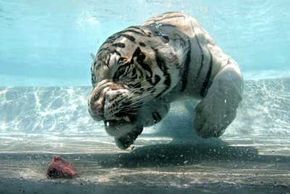In Norse mythology, Odin is the god of all the gods. However, he looks more like a cyclops from Greek legend, since he has only one eye -- he traded the other eye for a drink from the Well of Wisdom.
Another Odin, a white Siberian tiger who lives at Six Flags Discovery Kingdom near San Francisco, wouldn't just take a drink from the Well of Wisdom like the Norse god -- he'd dive right in. But Odin couldn't care less about gaining smarts; he just enjoys the water. The white tiger entertains crowds with his swimming capabilities. With eyes wide open and ears pulled back, the big cat freely jumps into a pool of water and dives to the bottom.
Advertisement
Tiger Image Gallery
Anyone who's ever tried to bathe a cat knows that these pets generally aren't fans of water. Even a few drops flicked their way will send cats scurrying in the other direction. There are exceptions to that rule, however. An extraordinary cat named Hawkeye has his own custom-made scuba diving gear that his owner designed and had made for a pretty penny. And it doesn't take coercing to get Hawkeye in the water; he'll hop into his owner's swimming pool of his own accord. Read more about Hawkeye's underwater adventures in How could a cat scuba dive?
But what would it take to coerce a 445-pound (201-kilogram) tiger to get wet?
Like Hawkeye, Odin doesn't mind the water either, although he has some added incentive for getting wet. His trainer tosses meat into the pool, which the white tiger eagerly dives in after by holding his breath to retrieve the tasty morsel. But it wasn't the trainer that initially gave Odin his water wings. Instead, Odin picked up the behavior from another tiger at the animal park.
Odin's swimming wouldn't come as a surprise to any knowledgeable tiger expert. Of all the big cat species, tigers in particular are known for their swimming capabilities. When most tigers swim, they don't spend much time fully submerged like the white Bengal, but taking a dip wouldn't be out of the ordinary since swimming serves a few key purposes.
Advertisement



